Help us LEAP forward with PTAB assistance for practitioners and inventors
Blog by Kathi Vidal, Under Secretary of Commerce for Intellectual Property and Director of the USPTO
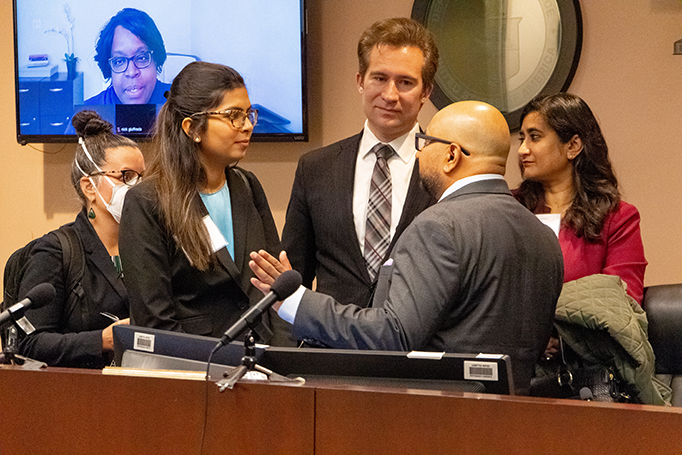
Since the moment I was sworn in as Director of this great agency two years ago, I have been guided by the conviction that we must open the doors of opportunity in the innovation community to everyone, not just a select few. Only when every inventor and entrepreneur has an equal chance to bring their new ideas and products to the global marketplace, on a level playing field, does our nation truly thrive.
There are many things we have done at the USPTO to push those doors of opportunity wide open, but I want to highlight a few in particular that I need your help in sharing with others. Collectively, they make access to the Patent Trial and Appeal Board (PTAB) easier and more transparent than ever, for both legal practitioners and the inventors they represent.
First, we are eager to engage with the public on our proposed rule to amend the criteria individuals must meet to practice before the PTAB. This rule will expand opportunities for more individuals to participate in our innovation ecosystem, while not compromising our goal of issuing and maintaining robust and reliable intellectual property rights. We encourage stakeholders to submit comments by May 21.
The next two programs are part of our continuing efforts, through the Legal Experience and Advancement Program (LEAP), to empower the next generation of advocates and prepare them for meaningful, impactful work early in their careers.
“LEAP to Chambers” brings eligible practitioners to a USPTO hearing facility, where a PTAB judge will give them a behind-the-scenes tour. They will get a feel for the hearing room by standing behind the podium and testing out their openings. They will learn how to display evidence at a hearing, and they may sit at the bench and view the hearing room and evidence from the judges’ vantage point. A remote judge also will join the tour to provide tips on how to most effectively argue before a hybrid panel of in-person and remote judges.
After the tour, judges spend time with practitioners highlighting effective advocacy techniques and answering questions. These conversations are a safe space for practitioners outside the context of a real argument or ongoing proceeding to seek clarification on PTAB procedures.
In “LEAP to Law Schools,” judges visit law schools and offer an overview of PTAB proceedings, including demonstration of a mock argument. By exposing law school students to PTAB so early in their legal careers, the USPTO encourages greater and more inclusive participation by law students in the intellectual property field and better equips them to practice before the USPTO.
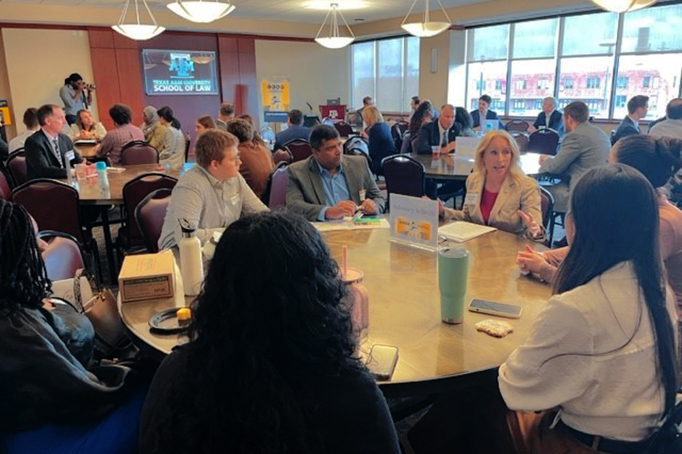
In addition to these two new programs, PTAB continues to offer LEAP-eligible practitioners the opportunity to present mock oral arguments and practice their advocacy skills before a panel of judges and receive individualized feedback.
Since LEAP launched more than three years ago, over 350 eligible practitioners and 135 law firms have participated. But we are still just getting started, and we need your help. Whether you are in-house or work for a large law firm, or anything in between, please share these free training opportunities widely within your professional networks, and encourage the next generation of practitioners to take full advantage of them.
We also recently launched a new PTAB Moot Court Competition for law students to develop and practice the written and oral advocacy skills needed for America Invents Act (AIA) proceedings. This free, fully virtual program is open to teams of students who will be enrolled in law school full-time or part-time during the 2024-2025 academic year. Students will get to work closely with an Administrative Patent Judge (APJ) coach, receive practical tips and experience on how to best present a case before the PTAB, and participate in live oral arguments before a panel of APJs. We encourage law school faculty members or administrators to visit the program webpage for more information and submit an interest form by March 31.
Another opportunity we need your help in promoting is the PTAB Pro Bono Program , which serves under-resourced inventors seeking to appeal a patentability rejection by an examiner. We launched the program in 2022 in collaboration with the PTAB Bar Association, and since then, a number of licensed patent attorneys, registered to practice before the USPTO, have offered their free services to represent independent inventors, inventor groups, and inventor-owned small businesses in ex parte appeals. Where we need your help most is in promoting the program more widely within the inventor community.
To be eligible for PTAB pro bono assistance, an individual inventor must:
• Reside in the United States;
• Have a total household income of less than 400% of the federal poverty guidelines;
• Successfully complete a training course consisting of two videos, one on how PTAB Pro Bono operates and how to apply for assistance, and the other on the ex parte appeal process;
• Apply to the program within one month from the date of an office action in which the claims have been twice or finally rejected; and
• Not be under an obligation to assign (sell or give ownership of) the application or resulting patent to a third party.
Inventors who are part of an inventor group of up to four known inventors must meet the qualifications listed above. Inventor-owned small businesses are eligible if they are 100% inventor-owned and if each inventor-owner meets the qualifications listed above. If the business was operating in the calendar year prior to the application for pro bono assistance, it must have had a total gross income of less than $150,000, and the business must expect/project a total gross income of less than $150,000 in the calendar year when the application for pro bono assistance is filed.
Please visit the LEAP and PTAB Pro Bono pages of the USPTO website for more information, share them with others, and feel free to contact me at Director@uspto.gov if you can’t find your answers there. I look forward to discussing these programs and more at the PTAB Bar Association Annual Conference on March 7.
Together, we can make a difference for the next generation of patent practitioners, the inventors they represent, and our nation’s future!
Posted at 09:21AM Feb 29, 2024 in USPTO | Comments[0]
AI and inventorship guidance: Incentivizing human ingenuity and investment in AI-assisted inventions
Blog by Kathi Vidal, Under Secretary of Commerce for Intellectual Property and Director of the USPTO

Posted at 04:42PM Feb 12, 2024 in USPTO | Comments[3]
Support for protecting and enforcing your IP in China
Blog by Kathi Vidal, Under Secretary of Commerce for Intellectual Property and Director of the USPTO
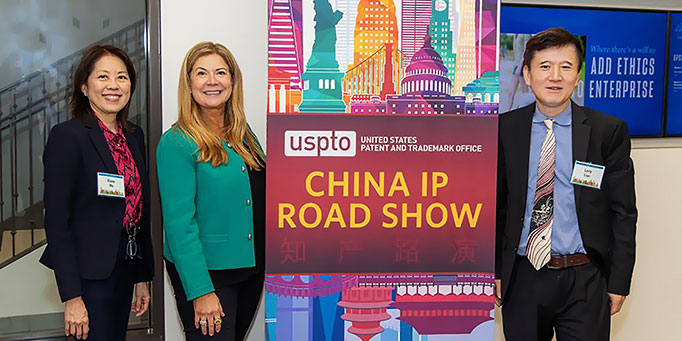
Since the start of my tenure as Director in spring 2022, protecting and enforcing intellectual property (IP) rights in China has been an essential part of our agency efforts to strengthen the global IP system. U.S. businesses operating in China regularly cite insufficient protection and enforcement of IP as a top concern, and the Office of the U.S. Trade Representative has placed China on its “priority watch” list for over a decade, detailing a long list of IP concerns reported by U.S. businesses operating in China.
I am committed to promoting a level playing field for U.S. rights holders in China and providing insight on the unique challenges they face. We are fortunate to have a USPTO team of attorneys and IP experts focused on China. The China team includes over a dozen stateside IP attorneys and three IP attachés and legal staff in Beijing, Shanghai, and Guangzhou, China. These experts engage with other federal agencies, U.S. stakeholders, and their Chinese government counterparts to advocate for U.S. rights holders doing business in and exporting to China.
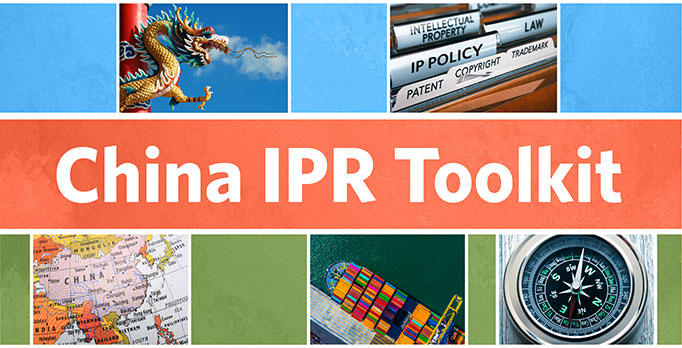
It can be difficult to do business in China. The China IPR Toolkit can serve as a helpful first stop on that journey. It is available as a free download from the USPTO website.
I’ve seen first-hand American businesses working to educate themselves on China IP. In October, I joined private sector and government experts in San Diego at the USPTO China IP Roadshow. These one-day, in-person events held around the country detail for local entrepreneurs and businesses how they can protect and enforce their IP in China. They are tailored to their specific locales, taking into account the leading local industries—biotech, manufacturing, agriculture, or the creative industries, to name a few. We bring in experts who can address the particular challenges faced by these businesses. We also offer the expertise and knowledge of the USPTO’s China IP specialists, local businesspeople, and IP experts.
Since 2017, we’ve held more than 30 China IP Road Show events in every corner of the country. To learn more about past and upcoming China IP Road Shows, visit the USPTO website.
In our work, I’m grateful for the leadership of U.S. Secretary of Commerce Gina Raimondo. Secretary Raimondo traveled to Beijing and Shanghai last year to meet with her Chinese government counterparts and representatives of leading U.S. businesses operating in China. She and China’s Minister of Commerce Wang Wentao agreed that U.S. and Chinese subject matter experts will hold technical discussions regarding strengthening the protection of trade secrets and confidential business information during administrative licensing proceedings in China. To facilitate that initiative, I have made the USPTO’s China IP experts available to support it and any other related IP initiatives that develop.
The China IPR Toolkit and the China IP Road Shows are just two of a number of initiatives spearheaded by our China team. I encourage you to visit the China IP page of our website to see the resources we offer, and sign up for future road shows and webinars.
Posted at 08:22AM Jan 18, 2024 in USPTO |
Improving our service to America’s innovators
Vaishali Udupa, Commissioner for Patents
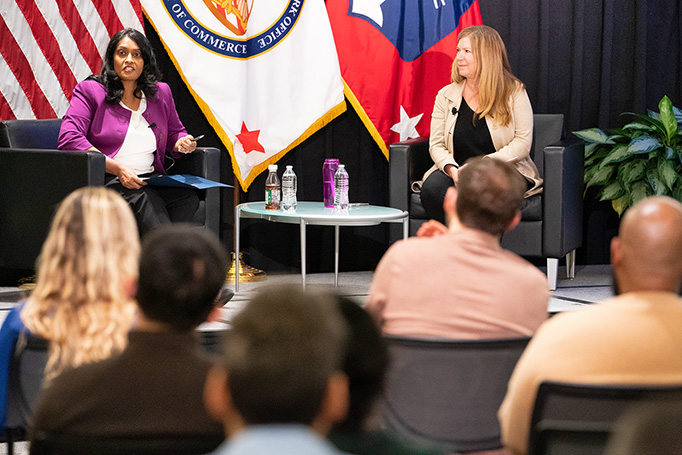
As we announced in September, as part of our modernization efforts to provide more extensible technology and functionality, the EFS-Web and Private Patent Application Information Retrieval (Private PAIR) tools are being retired after their decades of use as electronic filing and application management systems for our Patents customers.
Starting November 15, 2023, the Patent Center system will fully replace EFS-Web and Private PAIR.
Making this transition to Patent Center is essential to ensuring that our tools evolve, that we stay up to date on the latest digital capabilities, and that we continue to deliver excellent customer service to meet your needs.
We are postponing the original transition date (previously November 8) to better respond to and incorporate additional valuable stakeholder feedback into the Patent Center system. Specifically, we are working to increase usability for sponsored accounts with large amounts of customer numbers and address any related issues. We are also ramping up coverage to our Electronic Business Center to respond to questions in real-time and help ensure a smooth transition for our stakeholders.
A one-stop shop for Patents customers
Patent Center pulls all the steps of filing and managing a patent application together into one central system. It offers a next-generation user interface and better overall system performance and security. Patent Center also includes new features to streamline the application process:
- No need to create a new account: you can use the USPTO.gov accounts and sponsorships that you’ve already created for EFS-Web and Private PAIR.
- The ability to upload your patent application specification, claims, abstract, and drawings in a single DOCX document without having to manually separate sections.
- The ability to upload multiple documents at once using the drag and drop interface.
- The ability to download multiple documents at one time in a single PDF or ZIP file.
- The ability to confirm the status of submitted documents and successful payments with separate submission and payment receipts.
- In addition, if you want to get familiar with Patent Center’s features without actually submitting anything, you can explore Training Mode, an interactive simulation to safely practice filing DOCX and PDF documents. You’ll also receive real-time feedback.
Future updates
We’re not stopping here. Since its launch six years ago, we’ve rigorously tested Patent Center and made improvements based on your feedback. We will continue to use your input to enhance the system’s functionality. If you have a suggestion or an idea for new functionality or performance improvement send them to emod@uspto.gov. We review these ideas weekly. Retiring our legacy EFS-Web and Private PAIR systems ensures that we are better protecting confidential application materials and investing patent user fees responsibly. Maintaining these legacy systems during the development and testing of Patent Center made sense to ensure there was no interruption in service. Patent Center is now ready to become the sole system, and it is time to turn off the legacy systems so we can reinvest recovered resources into developing your ideas for new functionality and performance improvements. You can access instructional guides, resources, our on-demand webinar, a list of top 25 questions and answers from previous training sessions, and contact information for technical assistance all on the Patent Center information webpage. Thank you for all the feedback you’ve provided in Patent Center’s six years of operation. We appreciate your continued engagement as we seek to improve our service to you.
Posted at 01:41PM Nov 07, 2023 in ip | Comments[8]
Tips on taking control of your creative IP
Blog by Kathi Vidal, Under Secretary of Commerce for Intellectual Property and Director of the USPTO
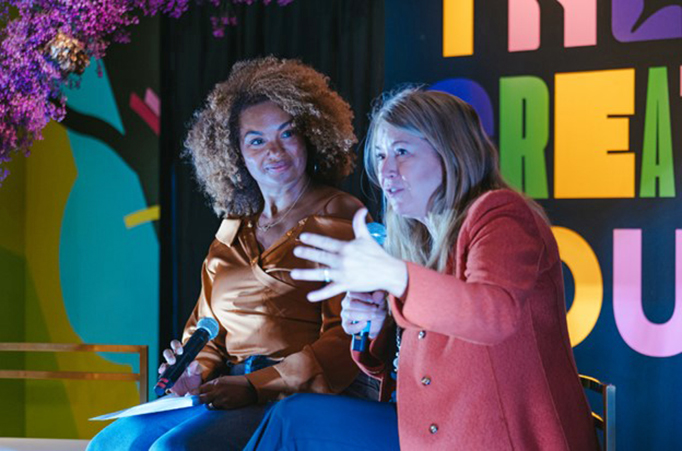 On September 20, Director Vidal spoke with Kim Tignor, executive director of Take Creative Control, about the importance of creators participating in the IP economy. (Photo courtesy of Take Creative Control)
On September 20, Director Vidal spoke with Kim Tignor, executive director of Take Creative Control, about the importance of creators participating in the IP economy. (Photo courtesy of Take Creative Control)
When I first began my tenure as Director in the spring of last year, I pledged to strongly advocate for the value of intellectual property (IP) and its protection. As we work throughout the world to strengthen the IP ecosystem through new laws, policies, practices and collaborations, I consider it an honor to also be an ambassador for IP, impressing upon those with great ideas – including our youth, women across the globe, and our military – the importance of protecting IP.
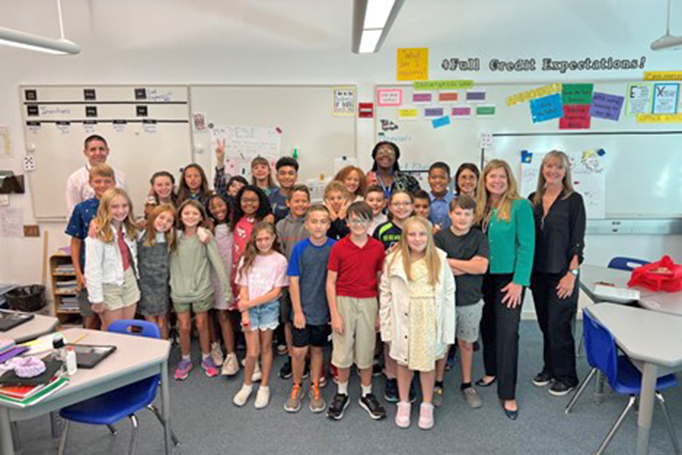
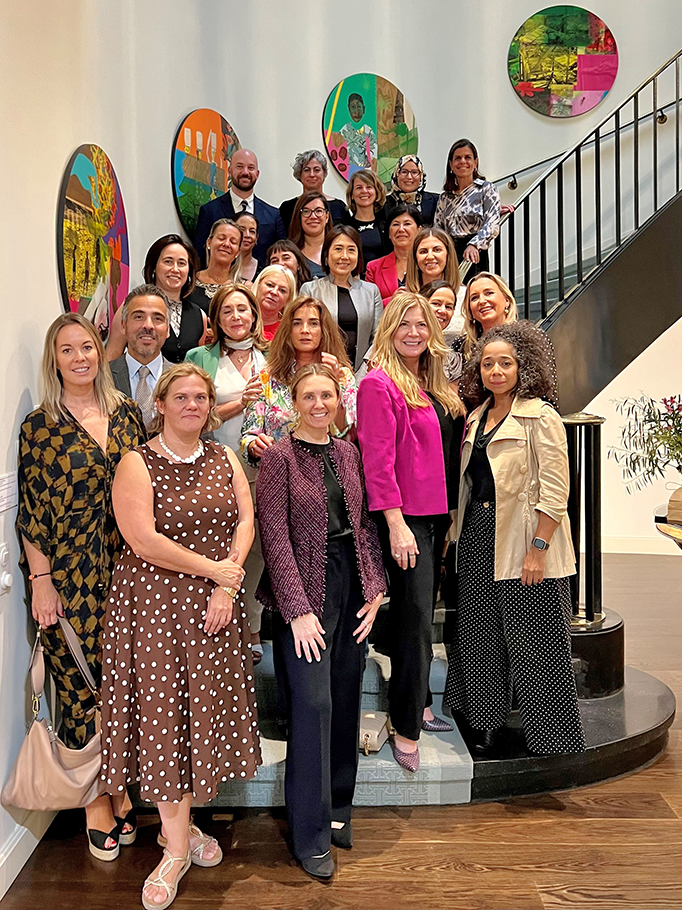 This month, preceding her trilateral meetings with Europe and Japan in Munich, Germany, Director Vidal spoke met with 5th graders on the military base in Rota, Spain and with women entrepreneurs at Ambassador Julissa Reynoso’s residence in Madrid, Spain
This month, preceding her trilateral meetings with Europe and Japan in Munich, Germany, Director Vidal spoke met with 5th graders on the military base in Rota, Spain and with women entrepreneurs at Ambassador Julissa Reynoso’s residence in Madrid, Spain
Patented inventions are in every common device and product you use every day, such as your smartphone, car, or even your hair dryer, brush, and comb. Indeed, the USPTO just granted the 1 millionth design patent for a comb created by Agustina Huckaby, an inventor and licensed cosmetologist from Fort Worth, Texas:
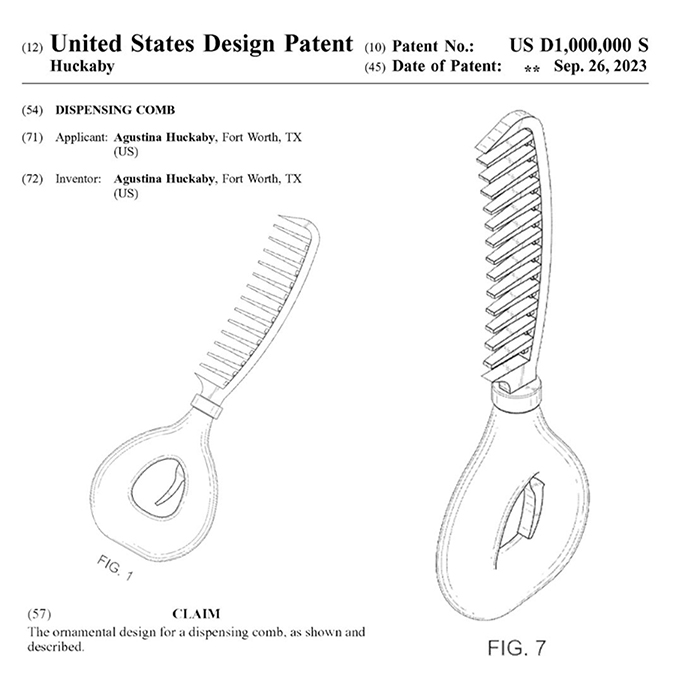
In fact, many products are covered by multiple patents, including for follow-on innovations that improved the product. One example I like to use is Thomas Edison, whose original light bulb that he submitted to the USPTO in the 1800’s is sitting on my desk at our headquarters in Alexandria, Virginia. When I go into classrooms and ask whether Thomas Edison invented the light bulb, the kids know! They say, “No - he just invented a better filament.”
In addition to being able to protect your idea or design with a patent, you can also protect your product, service or company with a trademark. Some widely recognized trademarks are the Nike swoosh; images of the brand names of products including Barbie dolls; Clorox bleach; the unique stitching on the back pocket of Levi’s jeans; and the name and some popular lyrics of musician Taylor Swift. Catchy slogans you come up with for your product or service, such as “If you spray it when you say it no problem” that two 10-year-old girls on a military base in Rota, Spain, came up for their spit-proof headset, can also be trademarked.
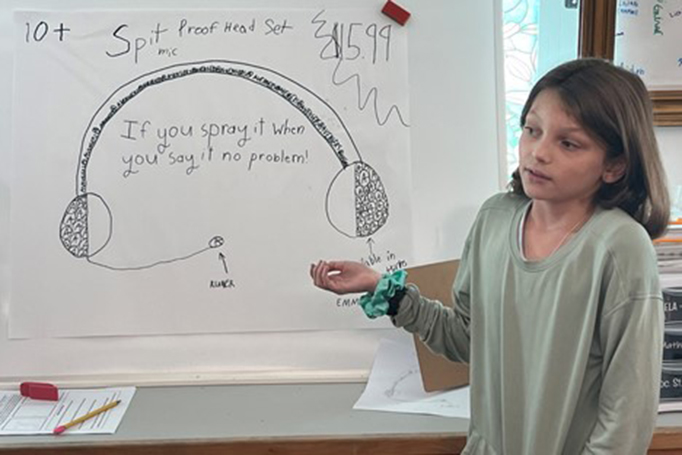 5th graders on the military base in Rota, Spain presenting their “spit-proof headset” to Director Vidal during her visit to the base.
5th graders on the military base in Rota, Spain presenting their “spit-proof headset” to Director Vidal during her visit to the base.
Trademarks can even be scents. Scent marks protect a unique smell from being copied by other similar products.
Play-Doh, for instance, has its scent protected. We recently posted this popular Instagram video asking members of the public if they could identify the unique smell of this scent mark - check out who immediately guessed it.
What about that poem you wrote? Or the picture you took at the school play (or one that turned out so well you may want to sell it online)? Copyrights are there to save the day and to protect you against someone else copying (or to compensate you if they do!). How about that great BBQ sauce that won first prize the state fair and you want to start bottling it and selling it at farmers markets (and maybe later in national stores or online)? Or that drink recipe you concocted? Or perfume? In comes trade secrets. If you take the right steps to ensure nobody has access to your “secret sauce” you may be able to protect your creation just like Coca-Cola did with their famous recipe. Indeed, intellectual property is all around us. Because anyone can be a creator. But people sometimes ask me why they should go through the trouble of protecting their IP. Simple: When you get a patent, trademark, create a work eligible for copyright protection – or protect your trade secret – it’s a valuable asset. You’re investing in yourself and your idea. Our research has found that companies in IP-intensive industries tend to employ more workers, whose average weekly earnings of $1,517 in 2019 were 60% higher than in other industries. Other research shows that protecting one’s IP is crucial to the success of their business. For example, according to a joint study by Harvard Business School and NYU’s Stern School of Business, when used as collateral, a company’s first patent increases venture capital funding by 76% over three years. It can also help serve as an important employee recruiting tool: The approval of a startup’s first patent application increases its employee growth by 36% over the next five years. Further, protecting your IP can also increase your market share – a new company with a patent increases its sales by a cumulative 80% more than companies that do not have a patent. As for trademarks, not only are they important assets, if you end up deciding to launch a business or expand to other areas in the U.S., a federal trademark that you can only get from the USPTO will protect you. You can use your trademark to stop copycat products at the borders or have online resellers remove copycat offerings. You can also use your copyright to have copycat material taken down from the internet. Confused about what type of intellectual property you might need? The USPTO now has an easy-to-use new online tool that lets you figure out what type of IP you have and whether it’s protectable by a patent, copyright, trademark, and/or trade secret. We call it the IP Identifier. It’s a very popular tool among those visitors to our website who are new to IP, with more than 100,000 visits to the page since we launched it earlier this year.
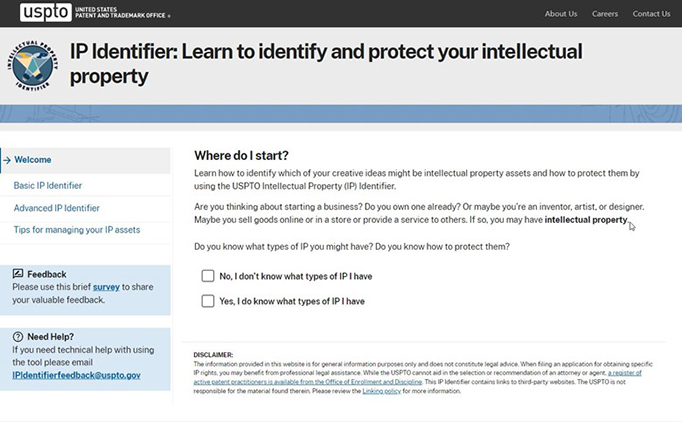
Registering your IP protects your IP – and you. Even during the period when one of our thousands of knowledgeable examiners is reviewing your application, just the submission of your application filing may provide some legal protection in the event someone later tries to claim your idea. And, having a “patent pending” can help you get funding!
Many applicants pursue the help and services of legal counsel. The 84 Patent and Trademark Resource Centers nationwide – often found in academic and community libraries near you – have lists of attorneys they can refer you to, in addition to providing free expert advice on filing and USPTO processes. And for under-resourced inventors, you may be eligible for free legal help filing an application through our Patent Pro Bono program or Law School Clinic program. Check out our information on free legal help.
For more information on USPTO programs, visit our Inclusive Innovation webpage. There are programs for kids, teachers, women, college students, military veterans and spouses, and more.
We hope to see you at a no-cost USPTO program soon!
Posted at 03:05PM Oct 11, 2023 in ip | Comments[2]
Latest updates on artificial intelligence and intellectual property
Blog by Kathi Vidal, Under Secretary of Commerce for Intellectual Property and Director of the USPTO
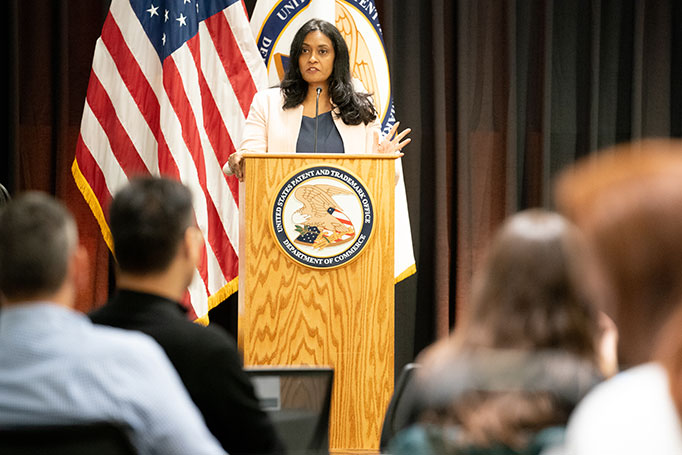 On
September 27, 2023, Commissioner for Patents Vaishali Udupa spoke at the
USPTO’s fourth AI/ET Partnership meeting about the USPTO’s critical role in
advancing emerging technologies and artificial intelligence (Photo by Jay
Premack/USPTO)
On
September 27, 2023, Commissioner for Patents Vaishali Udupa spoke at the
USPTO’s fourth AI/ET Partnership meeting about the USPTO’s critical role in
advancing emerging technologies and artificial intelligence (Photo by Jay
Premack/USPTO)
When it comes to artificial intelligence (AI), there is enormous potential for our country and for solving world problems — but there are significant risks as well. To shape the future of AI, we must act quickly but also thoughtfully and with your input.
Since taking office, President Biden and the entire the Biden-Harris Administration have moved with urgency to seize the tremendous promise and manage the risks posed by AI. The Biden-Harris Administration is currently developing an executive order that will ensure the federal government is doing everything in its power to advance safe, secure and trustworthy AI, and manage its risks to individuals and society. Our Administration will also pursue bipartisan legislation to help America lead the way in responsible innovation. As we advance this agenda at home, the Administration will continue working with allies and partners to establish a strong international framework to govern the development and use of AI worldwide.
The USPTO, and our sister agencies within the Department of Commerce, as well as the U.S. Copyright Office, play a critical role in this work. One of the USPTO’s top priorities is to ensure that the United States maintains its leadership in innovation, especially in emerging technologies (ET) such as AI. Our AI efforts align closely with the Administration’s whole-of-government approach to AI, including the National AI Initiative that seeks to advance U.S. leadership in AI. That is why, under my leadership, the USPTO created the AI/ET Partnership. Over the last year, the USPTO’s AI/ET Partnership has worked closely with the AI/ET community to gather public feedback through a series of meetings on topics related to AI and innovation, biotech, and intellectual property (IP) policy.
In collaboration with you, we have been working to swiftly, but also responsibly, incorporate AI into our work so that we can better serve the American public and increase the robustness and reliability of IP rights. We are integrating AI technologies into our next-generation tools to enhance the quality and efficiency of patent and trademark examination. Our examiners have conducted over 1.3 million searches using AI search tools. These tools also find potential foreign prior art relevant to their examination of a patent application by searching patent documents from over 60 different countries. We are assessing approaches for making these AI search tools publicly available. We are also working to extend search to images for design patents. And, our Trademarks organization is also looking to develop AI capabilities in image searching, classification, and identification of goods which will better assist our more than 750 trademark examining attorneys examining applications for trademark registrations.
We also have several user-facing AI initiatives in development and public beta, to help the public better navigate the patent and trademark systems. The USPTO Virtual Assistant enhances customer service by providing immediate, targeted answers to common questions. While currently available on several Trademark pages; we will be adding the tool to more USPTO pages soon. Our Inventor Search Assistant tool allows you to search for your own prior art to help determine if your invention is patentable (Learn more in this Inventors Digest article). Last year, we held an AI research competition where over 2,300 competitors from over 80 countries created AI models for a patent phrase-to-phrase matching challenge. We offer an AI Patent Dataset that – using a machine-learning (ML) approach that analyzed patent text and citations in patent applications and other documents – identifies patents issued from 1976-2020 with one or more AI technology components, including ML, natural language processing, computer vision, speech, and more.
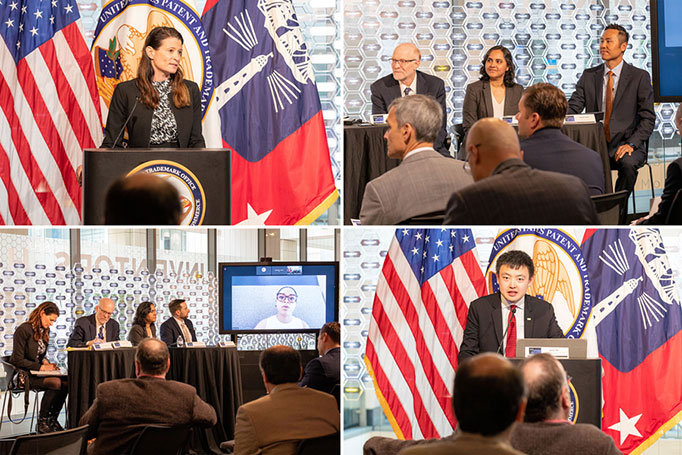 On April
25, 2023, the USPTO held one of several public listening sessions on AI and
inventorship (Photo by Michel Cleveland/USPTO)
On April
25, 2023, the USPTO held one of several public listening sessions on AI and
inventorship (Photo by Michel Cleveland/USPTO)
Our AI/ET Partnership Meeting on September 27 this week explored the many ways that AI is shaping the work of both the USPTO and those who practice before us, along with the role of USPTO data in advancing state-of-the-art AI research and AI throughout the innovation economy. Attendees heard from a distinguished and diverse lineup of AI researchers, IP practitioners, USPTO technologists, and interagency partners. And our economists demonstrated some of our AI data and research initiatives.
Given the
rapid adoption of AI, we are moving swiftly and carefully – including on patent
examiner training. In our report, “Inventing AI: Tracing the
diffusion of artificial intelligence with U.S. patents,” we found that AI is increasingly
important for invention, diffusing broadly across technologies, inventors,
organizations, and geography. For example, recently updated data from our
report indicates that around 80,000 of our utility patent applications in 2020
involved artificial intelligence – over 150% higher than in 2002. AI now
appears in more than 18% of all utility patent applications we receive. Illustrating
AI’s rapid diffusion across fields, patents containing AI appeared in about 9% of all
technologies examined by the USPTO in 1976, and spread to more than 50% by
2020. And, this data precedes what we have all seen in the past six
months.
For many years, we have offered AI related training through our Patent Examiner Technical Training Program (PETTP) and Site Experience Education Program. In fiscal year 2023, through PETTP, we held over 200 AI training courses, which were viewed over 8,000 times by our examiners. These programs keep patent examiners up to date on the latest technological developments, emerging trends, and recent innovations, including in AI. Examiners hear from and engage directly with scientists, engineers, and other experts from universities and innovative organizations, to learn the latest on the various technologies examined throughout the USPTO. Additionally, through a new partnership with Carnegie Mellon University, we are rolling out a 21-course curriculum over the next few months on AI for patent examiners tailored to their own needs. And we will soon launch a new Premier Lecture Series, bringing AI experts to share their insights with USPTO personnel to help strengthen our examination process. If you have expertise in AI, reach out to us at aipartnership@uspto.gov!
As for our other critical work, we are working to assess how our stakeholders’ use of AI impacts the work we do and, after hearing from you on inventorship, we are working to provide clarity on inventorship for AI-assisted inventions, to be followed by working with you on obviousness and other key areas of IP law that need attention in view of AI.
As we work on our own AI efforts and outreach, we coordinate closely with other agencies on their efforts, such as the U.S. Copyright Office (USCO), who recently issued at notice of inquiry (NOI) on copyright and AI. As the Administration's IP advisor and close partner with the USCO, the USPTO is looking forward to working with the USCO on these important issues as they gather public input and feedback related to AI and copyright. Initial written comments are due by 11:59 p.m. Eastern Time on October 30, 2023. Reply comments are due by 11:59 p.m. eastern time on November 29, 2023. Your feedback to the NOI is critical. We will use your feedback and the USCO’s findings to advise the Administration on policy around copyright and AI.
In addition, the National Institute of Standards and Technology (NIST) recently published a request for information seeking public input on how best to implement the U.S. Government National Standards Strategy for Critical and Emerging Technology. And, we published a parallel request for comment alongside NIST and the International Trade Administration (ITA) focusing on the intersection of those standards and IP. From AI to quantum technologies, NIST, ITA and the USPTO have been collaborating very closely at the intersection of standards, innovation and IP. The response dates for both requests is November 6, 2023.
Stay tuned as there is more on AI to come! For any questions or feedback on our AI efforts, or to suggest a topic for a future meeting, please contact aipartnership@uspto.gov.
Posted at 09:17AM Sep 29, 2023 in ip | Comments[4]
What to expect from our new trademark search system (and why we’re replacing TESS)
Guest blog by Dave Gooder, Commissioners for Trademarks
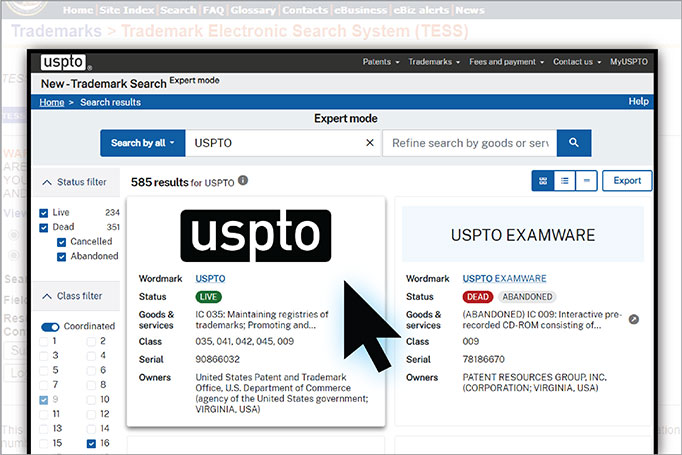
The Trademark Electronic Search System (TESS) has been a fixture of the USPTO’s information technology portfolio for decades. Those of us in the trademark community have grown accustomed to it, and perhaps even grown fond of it over the years. Maybe you have field tags and design search codes memorized, and you can formulate complex search strings to pull up the exact mark you’re looking for in a snap.
Although TESS has served us well, its long tenure is ending in November. The Bibliographic Retrieval System that has underpinned our internal and external search systems since 1993 is now outdated. On the bright side, we now have an opportunity to provide a more stable, modern search experience that can grow and adapt to the ever-evolving needs of the trademark community.
Our new search system recently launched in beta and we need your help to further its development. Our priority now, especially in the beta phase, is listening to your perspective on what works and what doesn’t, in order to optimize your search experience. To this end, I encourage you to use, learn, and express your feedback and suggestions on the new search. Your feedback will guide how we prioritize and develop updates beginning in 2024 and continuing for the life of the search system.
We understand that acclimating to a new interface and search
syntax takes time and look forward to holding several virtual events to help you
get familiar with the new system:
·
Demo
of the new trademark search system, September 26, 11 a.m. to noon ET
· Demo of the new trademark search system, September 28, 3-4 p.m. ET
·
Federal
trademark searching: Basics, October 2, 2-3:30 p.m. ET
· Federal trademark searching: advanced techniques, October 16, 2-3:30 p.m. ET
Thank you for the valuable feedback you’ve provided thus far, and please keep it coming. As we strive to transform your search experience for the better and to strengthen our IT infrastructure, we’re grateful for your support and engagement.
Posted at 11:18AM Sep 25, 2023 in trademarks | Comments[8]
How the domicile address requirement advances our trademark anti-fraud efforts
Guest blog by Dave Gooder, Commissioner for Trademarks
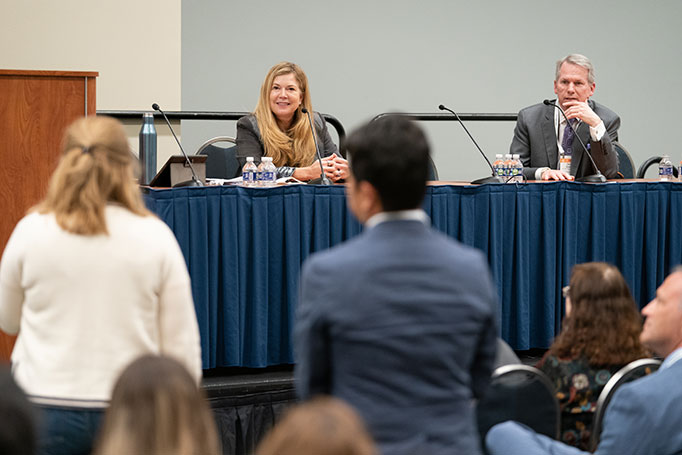
Director Kathi Vidal and Commissioner for Trademarks Dave
Gooder speak to stakeholders at the International Trademark Association meeting
We recently issued an examination
guide to clarify the steps examining attorneys must take to evaluate the
validity of a trademark applicant’s “domicile” as included in their
application. This requirement is also a key part of our comprehensive effort to
fight trademark filing fraud. In this blog, we offer a little more about what
it is, why it’s so important, and what you can do to help.
First, a little background: The Lanham Act requires us to
collect an applicant’s domicile information, and we do so via their domicile
address. An applicant’s domicile address depends on whether they are a natural
person or an entity (such as a corporation). For an individual, domicile means
the place where the person resides and intends as their principal home. For a
juristic person, e.g., a corporation or partnership, domicile means the
principal place of business where the senior executives or officers ordinarily
direct and control the activities of the business. Prior to 2019, USPTO presumed
that the applicant’s listed address was the applicant’s domicile and we did not
refuse customers who provided PO boxes.
In 2019, to better combat the rapidly rising number of trademark scams that were impacting both our customers and us, and to improve accountability for the accuracy of information provided in applications, we issued notice and comment rulemaking and subsequently began requiring trademark applicants and
registrants based overseas to be represented by a U.S.-licensed attorney (also known as the “U.S. Counsel Rule”). At that time, due to our need to enforce
the U.S. Counsel Rule and the heightened risk of its abuse, we began requiring
a street address for the domicile address.
In a world where bots and anyone or anything can file a
trademark application, the U.S. Counsel Rule helps us determine whether or not
the applicant is indeed a real person who either lives or has authorized
representation in the United States. It also helps us know if an applicant
needs to appoint a new attorney if they decide to change counsel.
Unfortunately, the U.S. Counsel Rule has not stopped some
determined scammers who seek to evade the requirement for domicile. Since 2019,
we’ve issued 258 final orders for sanctions for violations of the U.S. Counsel
Rule that terminated 18,789 invalidly filed applications and sanctioned 3,297
registrations. This includes thousands of incidents where foreign applicants
have used the same false U.S. address to avoid having to hire a U.S.-licensed
attorney, or where they appear to have hijacked U.S. attorney credentials and
added those credentials without the attorney’s awareness or permission to
applications in order to create the appearance that they have hired U.S.
counsel.
Our review of suspicious submissions has even revealed U.S.-licensed
attorneys cooperating with foreign filing mills who are filing applications
that violate USPTO
Rules of Practice, including the rules on signatures and certifications,
and the Rules of Professional Conduct. A domicile address is crucial to
combatting these scams.
Importantly, if an individual feels like their personal
safety is at risk if the domicile address appeared in publicly viewable fields,
we provide them the option to redact the domicile address by filing a Petition to the
Director. Additionally, we are committing new resources and teams to
strengthen and uphold the integrity of our IT systems.
The significant and dangerous problems posed by trademark scams
and application fraud should serve as a clarion call to our entire trademark community.
That’s why we ask for all those in the community to consider ways they can
support these efforts. We welcome all ideas at TMScams@uspto.gov, and we look forward to even
more opportunities to hear from you on this and other important anti-fraud
initiatives.
We are humbled and honored to serve this incredible
community that is driving our nation’s economy through the development of new
brands and the business growth that is fueled by strong trademarks. We are grateful for your support.
Posted at 10:46AM Aug 30, 2023 in trademarks | Comments[9]
Working globally to address climate change through sustainable innovation
Blog by Kathi Vidal, Under Secretary of Commerce for Intellectual Property and Director of the USPTO
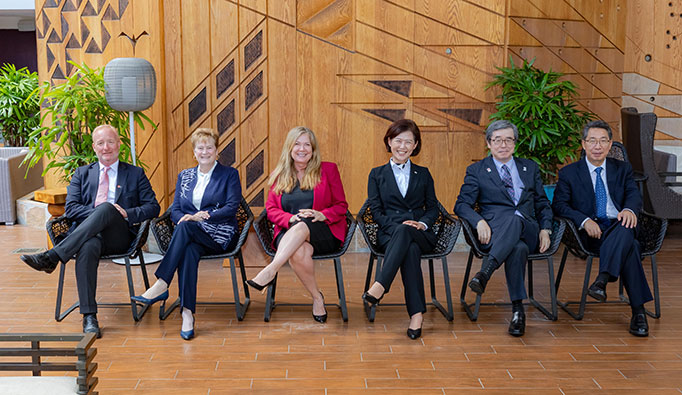
Recently, I had the privilege of hosting the leaders of the largest intellectual property (IP) offices in the world – the European Patent Office (EPO), the Japan Patent Office (JPO), the Korean Intellectual Property Office (KIPO), and the China National Intellectual Property Administration (CNIPA), along with the World Intellectual Property Organization (WIPO), for the annual meeting of the IP5, which took place in Hawai’i. I then led the USPTO delegation to the 64th Assemblies of the Member States of WIPO, an annual meeting with over 190 international IP offices from around the world in Geneva, Switzerland.
One topic of international concern to us all was how to work together to support sustainable innovation and as we look to solve global climate change. There is a pressing need for more innovation in the green tech space, and we need new technologies to mitigate the effects climate change. This is an international issue that affects all of us, and we discussed how we can work together to bring sustainable innovations to global impact.
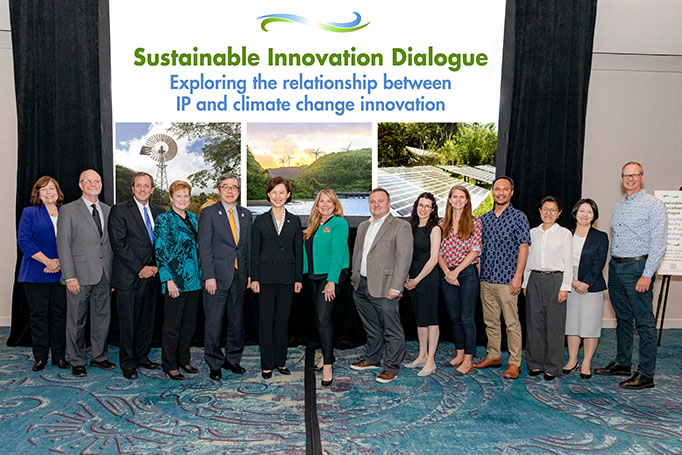
During our sustainable innovation dialogue at IP5, we discussed how we can work together towards a goal of net-zero carbon emissions to help mitigate climate change and preserve our environment. The IP5 leaders shared information on initiatives that encourage patent filings in climate technologies in their countries, streamline examination, and encourage eco-friendly efforts, such as paperless filing and energy efficiency. We brought together innovators, accelerators, and funders, as well as our sister agency, the National Oceanic and Atmospheric Administration (NOAA), to determine how we can be a catalyst to bring climate change technologies from research to the marketplace. Read more about the joint commitment to this important issue, and learn about current trends and programs across the IP5 countries in the Climate Initiatives Booklet.
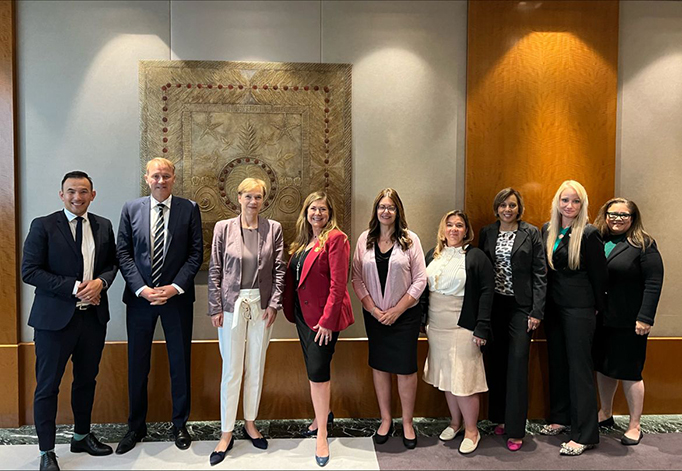
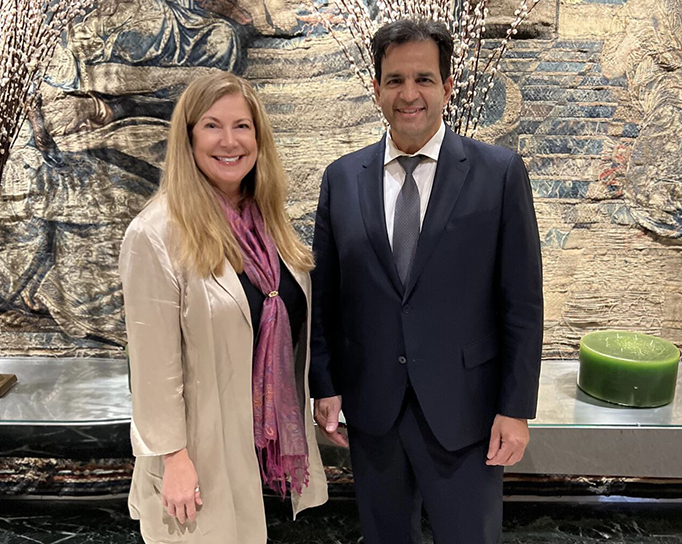
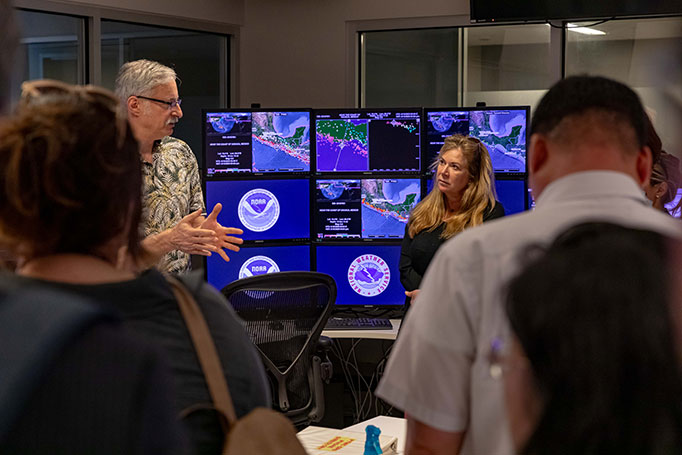
Posted at 03:29PM Aug 09, 2023 in USPTO | Comments[6]
Supporting our military community
Note: This blog originally published on the Commerce blog.
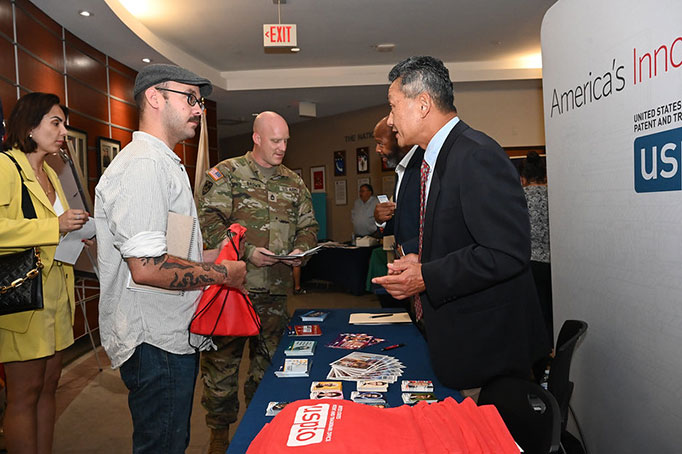
USPTO staff Alford Kindred and Harry Kim share entrepreneurship resources with military personnel and spouses at Hanscom Air Force Base (Photo courtesy of Todd Maki, Hanscom Air Force Base)
Last week, Secretary of Commerce Gina Raimondo joined Under Secretary of Commerce for Intellectual Property and Director of the USPTO Kathi Vidal at Hanscom Air Force Base, Massachusetts, for an Entrepreneurship Essentials Workshop and Resource Fair.
Over 100 military personnel, military spouses, and veterans attended in-person, with hundreds more online, as they heard from experts in business development and intellectual property (IP). Successful military spouses and veteran entrepreneurs discussed how they started businesses, and the resources and tools that helped them. From honing a business plan to protecting a brand and ideas, to market analysis and financing, the event included tips and resources on every angle of entrepreneurship.
“We want to figure out how to get the resources that we have within the Commerce Department, including at the USPTO, to assist veterans and their families,” Secretary Raimondo said.
Just a few weeks ago, President Biden signed an executive order to boost the economic and career prospects for military spouses and veterans, including service members approaching retirement.
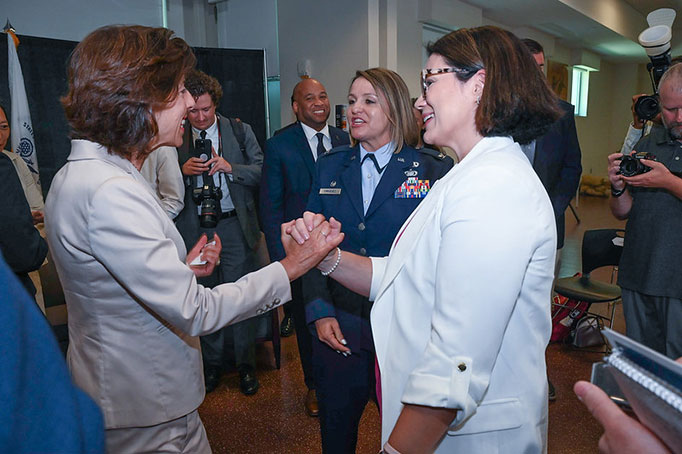
Secretary Raimondo greets Kim Howell, master of ceremonies for the Entrepreneurship Essentials Workshop and Resource Fair, and U.S. Coast Guard spouse (Photo courtesy of Todd Maki, Hanscom Air Force Base)
“President Biden is incredibly serious about supporting our service veterans and their loved ones,” Secretary Raimondo said in her remarks at Hanscom. “He has tasked each of us in his Cabinet about being proactive.”
Along these lines, the Secretary added, “the question is, what can we do at the Commerce Department?”
The answer, according to Secretary Raimondo, is for the Department to help veterans and their loved ones start businesses. She pointed out that the unemployment rate among military spouses is approximately 22% -- much higher than the national unemployment rate. Starting small businesses can help to reduce that spousal unemployment rate, while giving veterans and their families flexibility.
Also during the half-day event, Director Vidal pointed to the success that Hanscom has had with its Pitch It program. The program consolidates a wide range of technology market research functions, eliminating duplication and easing the pathway to public-private innovation.
“I was thrilled to learn about the work of the Hanscom Innovation Team, and the success you’ve had with your new Pitch It program,” Director Vidal told the Hanscom event on July 28. “We’d love to see it replicated throughout the country.”
“Entrepreneurship can be a game-changer for military spouses and for veterans,” said Director Vidal.
“For service members who are on the brink of making a leap into the civilian world, starting a business can be a viable second career.”
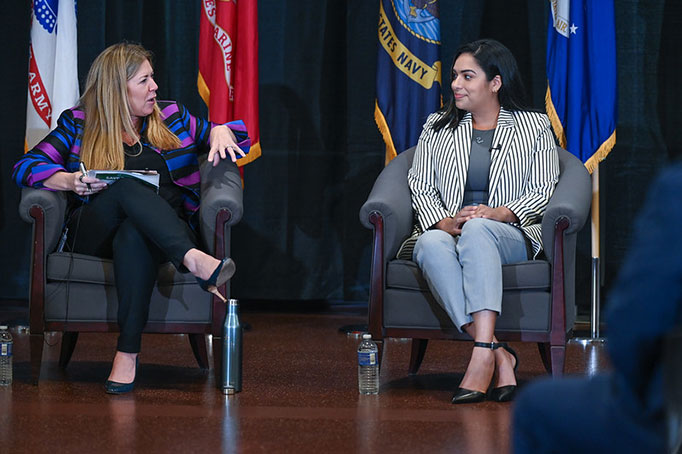
Director of the USPTO Kathi Vidal (left) speaks with Air Force veteran and entrepreneur Liseth Velez during a panel on business development resources (Photo courtesy of Todd Maki, Hanscom Air Force Base)
These efforts align with First Lady Jill Biden and the White House’s Joining Forces Initiative, which centers on employment and entrepreneurship; military child education; and health and well-being. The USPTO is working to support transitioning service members, military family members, and veterans to bring their innovations to life, build businesses, and protect their creations’ IP.
Across multiple agencies, including at the Commerce Department, the federal government under President Biden’s June 2023 executive order has been working to “increase the economic security of military and veteran spouses, caregivers, and survivors.”
The “bottom line is, we want to help you, we want to help you start a business, we want to help you grow your IP,” Secretary Raimondo told the military audience. “All the resources at the Commerce Department are available to you.”
Throughout the U.S., veterans own nearly two million businesses, which employ more than 5.2 million Americans, according to U.S. Census figures. At the USPTO, almost 10% of its 13,000-strong workforce is comprised of veterans, noted Director Vidal, whose father was both a veteran and an entrepreneur.
If you are affiliated with the military and interested in starting your own businesses, visit the USPTO’s entrepreneurship resources for the military community page or contact militaryoutreach@uspto.gov.
Posted at 11:20AM Aug 01, 2023 in ip | Comments[6]
Patenting innovation in climate science
Note: This blog originally published on the NOAA Research blog.
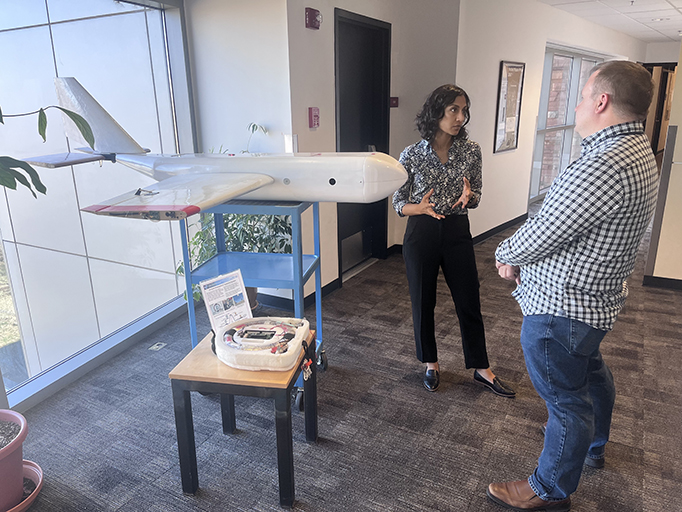
Parikha Mehta and Wayne Mackenzie discussing Dr. Bianca Baier’s innovative AirCore atmospheric sampling device and the HORUS glider at the NOAA Global Monitoring Laboratory in April 2023. Credit: NOAA
A Q&A with Parikha Mehta from the U.S. Patent and Trademark Office
Parikha Mehta has spent the last four months focused on the intersection of intellectual property and climate and environmental technologies while on an employee exchange (known as a detail) at NOAA from the U.S Patent and Trademark Office (USPTO). Her goal: Help researchers understand the importance of protecting their inventions so that NOAA’s research and technology can better serve the public and inspire future innovation.
The work overlaps with her usual job as a senior patent examination policy advisor at USPTO. “In my USPTO role, I focus on advising all types of stakeholders on our patent policy– soup to nuts of the whole patent process,” she says.
At NOAA, Mehta visited labs and fisheries science centers and interviewed researchers about their knowledge of the patent process and technology transfer.
We sat down to ask her about her experience, and intellectual property issues.
How did you hear about the employee exchange opportunity with NOAA? What motivated you to apply?
I heard about this opportunity through the USPTO detail announcement program; our agency is really supportive of career development through short-term reassignment opportunities. My background is in science and engineering, and I was excited for the chance to spend some time a little closer to that. I was also eager to share my knowledge of patent law and policy to hopefully help people who are trying to solve problems I care about personally. Before I started this detail, I knew broadly that NOAA was engaged in important research in a lot of different areas, but I didn’t appreciate the full scope of the agency’s impact until I got here. I’ve so enjoyed talking to the talented scientists and engineers here; meeting people and learning about their work has been incredibly rewarding, and also just a lot of fun.
Why is it important for researchers to patent inventions?
I’ve been inspired by how passionate NOAA researchers are about using science and engineering to help the public and the planet. Patents are a great vehicle for that, because they create a pathway for transforming innovation in the lab into something that the public can access and benefit from in day to day life.
Patents are also a tool for protecting the integrity of the important work that’s being done at NOAA. If somebody else tries to claim ownership of an idea, or use it in a way that doesn’t meet NOAA’s high standards, that can harm the agency and the public. Patents can provide insurance against those things. For example, I met several NOAA researchers who are working on innovative tools for collecting improved data from the ocean or the atmosphere. If those tools are patented, NOAA can confidently share them for broader public use knowing there is a measure of protection against anyone else distributing sub-standard knockoffs or erasing NOAA’s rightful credit for that innovation.
What is holding people back? Why do you think people don’t seek out a patent?
I think it’s mostly a matter of awareness. Scientists, engineers, and managers are often unfamiliar with how patents work, how they relate to federal research, and how to apply for them. The next two USPTO detailees will use what I’ve found to help NOAA’s research workforce learn about these topics, and hopefully help them feel more comfortable and confident when initiating discussions about how to protect NOAA inventions.
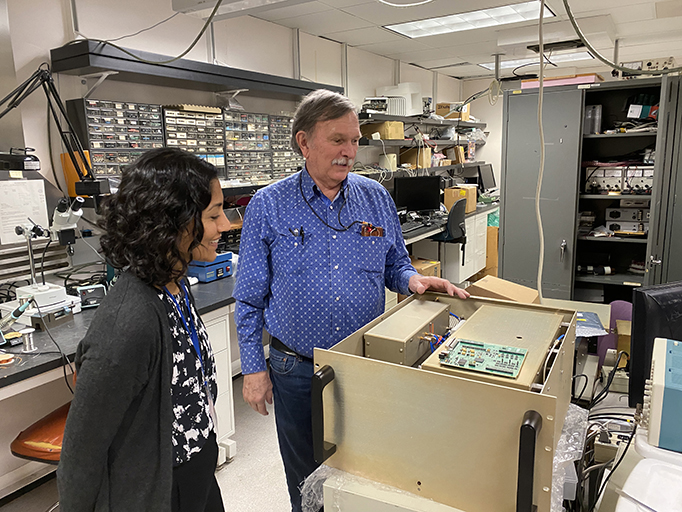
Dr. Paul Johnston showing Parikha an engineering work-in-progress in his lab at NOAA’s Physical Sciences Lab in April 2023. Credit: NOAA
What do you say to someone who is hesitant about patenting?
Researchers sometimes feel that their inventions aren’t suitable for filing a patent application because they are too niche, too specific to a particular problem they are trying to solve in their lab. They assume that nobody else is going to want or be able to use their invention,so they talk themselves out of trying to pursue a patent for it. To that, I would say don’t sell yourself short; no invention is too small. The NOAA Technology Partnerships Office has talented people who can guide that part of the decision making process; all you have to do is let them know you invented something, and they’ll help figure out the best path forward from there.
What has been the biggest surprise to you about NOAA and the culture here?
I don’t know if I would characterize this as surprising, but everyone’s strong mission identity and commitment to public service here has definitely made an impression on me. People show up to work here because they genuinely want to do good and help others; this really shone through in my interactions with every person I met at NOAA, not just the researchers. . It’s been wonderful, and probably one of the things I will remember most about this experience.
Mehta is the first of three USPTO employees assigned to NOAA this year. While Mehta’s been working at NOAA, another detailee has also gone from NOAA to USPTO to share climate science with their staff and advise on USPTO green initiatives. In a forthcoming article we will talk to that detailee about their experiences.
Posted at 07:39AM Jun 27, 2023 in USPTO | Comments[20]
Our plan for the future
Blog by Kathi Vidal, Under Secretary of Commerce for Intellectual Property and Director of the USPTO
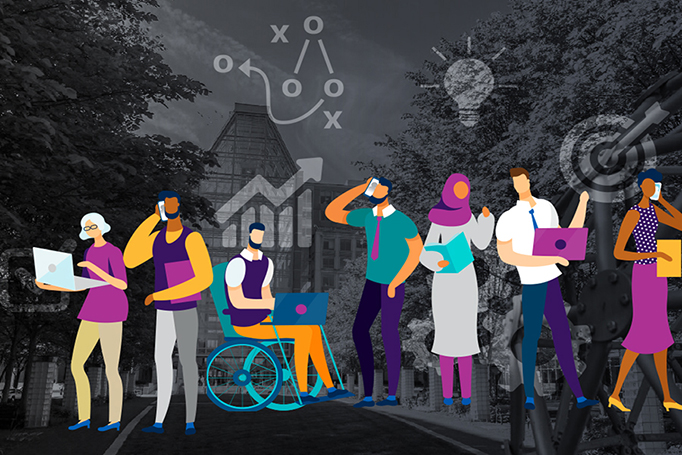
It’s been a work in progress for many months, and today, I’m excited to announce the publication of our 2022-2026 Strategic Plan. We gathered extensive comments from our employees, public advisory committees, IP industry groups, and the public to help shape this document into a clear and consistent plan. I’m grateful to everyone who provided feedback throughout the planning process to make this plan ambitious, focused, and relevant.
This plan outlines our five strategic goals for the next few years:
1. Drive inclusive U.S. innovation and global competitiveness;
2. Promote the efficient delivery of reliable intellectual property (IP) rights;
3. Promote the protection of IP against new and persistent threats;
4. Bring innovation to impact for the public good; and
5. Generate impactful employee and customer experiences by maximizing agency operations.
As you review the document, you’ll notice we’ve added measurable goal-based objectives to better quantify our continual progress. You’ll also see that we’ve modified our mission and vision to better reflect our position as America’s innovation agency.
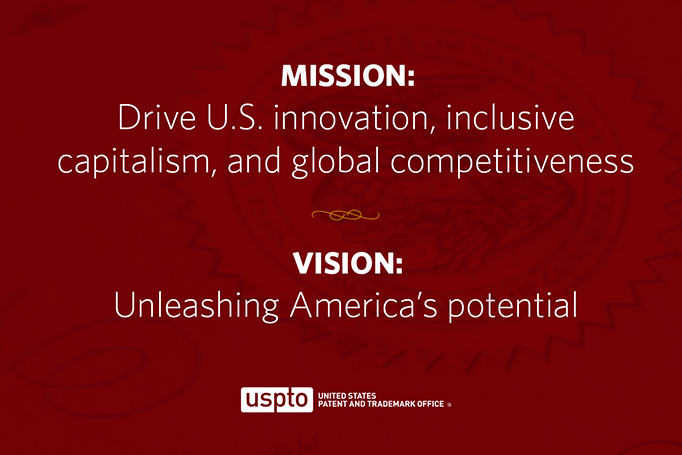
As I said in my one-year anniversary blog, my focus for the next 12 months is on impact. Between various engagement events and virtual feedback options, I’ve heard from thousands of you. We’ve listened. We’re reimagining our agency for the future. This plan clearly documents how we will achieve the greatest effects.
Every day, every one of us at the USPTO works to drive U.S. innovation, inclusive capitalism, and global competitiveness to unleash America’s limitless potential. I thank you all once again for joining us on this journey of evolution. As always, my virtual door remains open to you through the Engage with the Director page. We appreciate you and look forward to working with you to meet—and even exceed—our goals!
Posted at 10:19AM Jun 07, 2023 in ip | Comments[14]
Ready, set, compete! How we’re helping veterans and military family members innovate and start new businesses
Blog by Kathi Vidal, Under Secretary of Commerce for Intellectual Property and Director of the USPTO
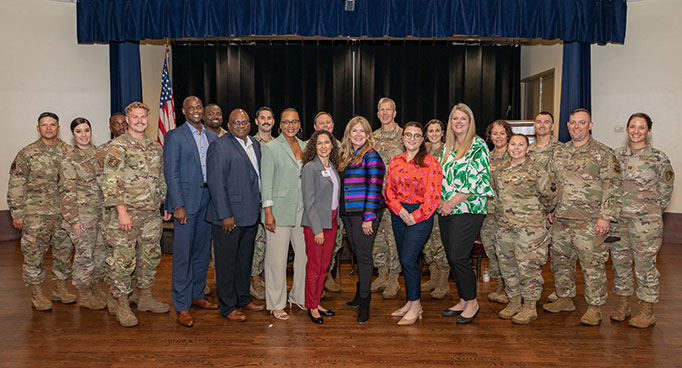
America’s inventors and entrepreneurs power our nation’s economy, competitiveness, and security. Many of America’s outstanding innovators and leaders are veterans. The skills they gained from their service, including teamwork, integrity and being organized, disciplined, adaptable, and focused, prepare them well for entrepreneurship. In fact, veterans have a proven track record of engaging in business ownership at higher rates than their peers in the civilian sector.
For service members preparing to transition into the civilian world, starting a business can be a viable second career. And for military spouses, self-employment can help provide professional and economic stability to weather the constant change that the military lifestyle brings. In alignment with First Lady Jill Biden and the White House’s Joining Forces Initiative that centers on the three core pillars of employment and entrepreneurship, military child education, and health and well-being, we are working to encourage and support more transitioning service members, military family members, and veterans to bring their innovations to life, build successful businesses, and protect their creations with intellectual property.
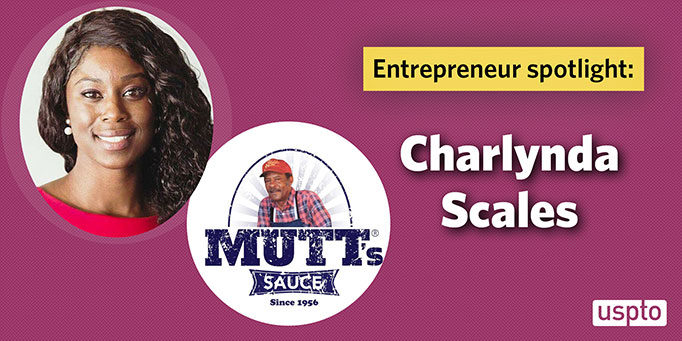
Take Charlynda Scales. A U.S. Air Force veteran and entrepreneur, she is the founder and CEO of Mutt’s Sauce LLC®, “the sauce for every meal.” Her late grandfather and fellow Air Force veteran Charlie “Mutt” Ferrell originally created the specialty sauce and left her the recipe, which she then turned into a successful business. At our Veterans Innovation and Entrepreneurship Program last year, she spoke about how the skills she gained in the military helped her launch her business. She offered the following advice for other veteran entrepreneurs: “When you have served in the military and you decide you want to go into entrepreneurship, you are strengthening the country by being a business owner. Holding on to your core values, being a good person, and service before self - those things that we learned in the military - that’s what sets you apart from everyone else.”
Growing up in a career military family, my father served in the U.S. Navy as a senior chief and I spent my childhood on military bases in the United States, Panama, Germany, and the Azorean Islands (Portugal). I’m grateful for the opportunity to connect with service members and their families, and share information about the resources we provide at the USPTO – from trainings on patent and trademark basics to free legal services – that can help them become successful entrepreneurs. Our goal is simple: to shine a light on what starting a business looks like, what it requires, and who you can turn to for help on your journey.
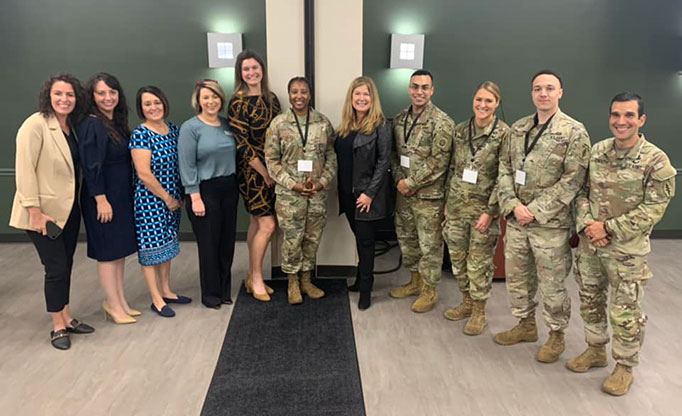
On November 22, 2022, Director Vidal met with service members and their families at Fort Bragg, NC, to discuss USPTO resources that can help them start their own businesses.
Recently, I met with military spouses and family members at Fort Bragg, North Carolina and MacDill Air Force Base, Florida to discuss essential skills every entrepreneur needs to know. And on June 9, we’ll be holding an event at Joint Base Pearl Harbor-Hickam. During these events, we go over the many aspects of entrepreneurship, from honing your business plan and protecting your brand and ideas, to market analysis and financing. Our military outreach events also feature successful military spouses and veteran business owners who share their personal experiences in entrepreneurship. Contact us if you’re interested in hosting one of these workshops in the future.
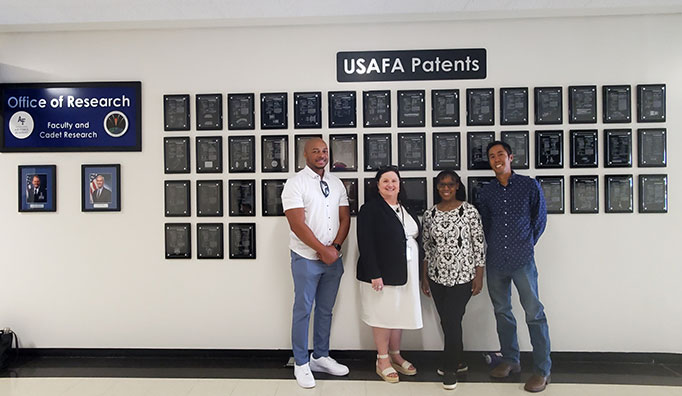
Our USPTO regional offices also reach out across the country meeting innovators where they are with resources to jumpstart their businesses. From in-person and virtual events to networking opportunities, we are joining forces with local organizations and bringing entrepreneurship training directly to the military community.
Dragon’s Lair 8 competition finals at the University of South Florida on March 29 (Photo by Michael Cleveland/USPTO)
I also had the pleasure of serving as a judge in the latest Dragon’s Lair competition co-hosted by the U.S. Special Operations Command and 18th Airborne Corps at the University of South Florida’s Research and Innovation Park in Tampa, Florida. Now in its eighth installment, service members from across the U.S. Department of Defense (DOD) submitted their ideas for innovations to meet future challenges. The eight finalists were selected from among 80 ideas that represented every service within the DOD, and all ideas included developing intellectual property. The innovators really used their boots on the ground knowledge to see their projects through and create concrete solutions for real problems the Army currently faces. The winning innovation was a mold conditions awareness tool, a 3D-printed device that uses sensors to detect temperature and humidity levels within barracks rooms to identify early signs of mold, presented by U.S. Army 1st Lt. Chris Aliperti and Pvt. Salem Ezz from the 3rd Infantry Division. Congratulations to all the finalists in the competition on their phenomenal ideas.
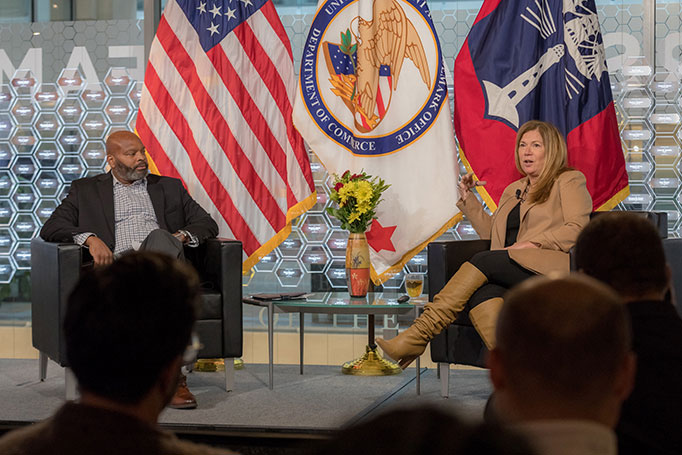
We also actively recruit veterans, and they play an
integral part of our operations at the USPTO. Many veterans have chosen to
continue their invaluable service to our country by joining the USPTO, and they
contribute to our mission across our agency in the areas of science and
engineering, information technology, contracts, procurement, finance,
administration, project and program management customer support, and more. In fiscal year 2022, 11% of our
new hires were veterans. Learn more about veteran hiring at the USPTO.
Expanding our outreach to military families and veterans is more important than ever. By highlighting opportunities and creating more connections to resources to promote self-employment, we can help create a new era of economic stability and professional portability for military spouses and our veterans who have served.
If you are affiliated with the military and interested in starting your own businesses or joining our workforce, we are eager to serve you. To learn more, visit our new page on entrepreneurship resources for themilitary community or contact us at militaryoutreach@uspto.gov. You can also connect with a regional USPTO office near you, check out our free resources for inventors and entrepreneurs, and view our upcoming programs. And stay tuned for our popular Veterans Innovation and Entrepreneurship program hosted each November.
Posted at 02:08PM May 25, 2023 in ip | Comments[3]
Patent Pro Bono Program expands and reaches underserved populations with free legal services
Guest blog by Derrick Brent, Deputy Under Secretary of Commerce for Intellectual Property and Deputy Director of the United States Patent and Trademark Office
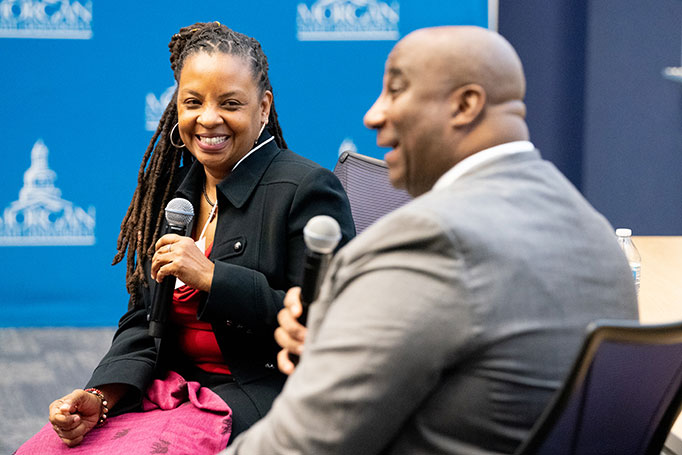
Over the past few months, I have been visiting cities across the country on a nationwide tour to share information about our Patent Pro Bono Program and other free and useful services for entrepreneurs. From Wake Forest University to Historically Black Colleges and Universities such as Morgan State, North Carolina A&T and Howard University, Director Vidal and I have been meeting and connecting with pro bono service providers, entrepreneurs, and students to discuss issues such as the value of intellectual property (IP) for small businesses, and bringing new entrepreneurs and inventors into the innovation ecosystem.
Entrepreneurs discussed how USPTO services like the Patent Pro Bono Program helped them grow their businesses and reach the marketplace. Volunteer legal counsel and clinic students expressed how meaningful it was to be part of the entrepreneurial journey. These programs are making a real and measurable impact.
Recently, we celebrated the 100th patent recipient in Minnesota who obtained assistance through LegalCORPS, a nonprofit based in Minneapolis and the first USPTO patent pro bono regional program. (Learn more in this Black Enterprise article and the Minnesota Star Tribune.) Soon after that great experience, I visited Penn State University to help launch the newest patent pro bono program. Penn State is doing some amazing work by combining their legal program with their entrepreneurial education program, thus giving inventors a chance to build a product and a business, together. I look forward to meeting with more of our regional programs in the future, and collaborating to find more ways and more services to provide.
Since the pro bono programs began collecting and sharing information in 2015, the Patent Pro Bono Program has provided more than 95,000 hours of free legal services to independent inventors and small businesses. That assistance has resulted in more than 2,000 patent application filings, amounting to millions of dollars in donated services since 2015. Last year, the Patent Pro Bono Program had more than 90 patent practitioners reporting 50 or more hours each of patent pro bono service to USPTO pro bono programs. In addition, more than 25 corporations and law firms contributed significant hours to one or more participating regional programs – a record number of organizations. These volunteers assisted with filing 220 patent applications with the USPTO in 2022.
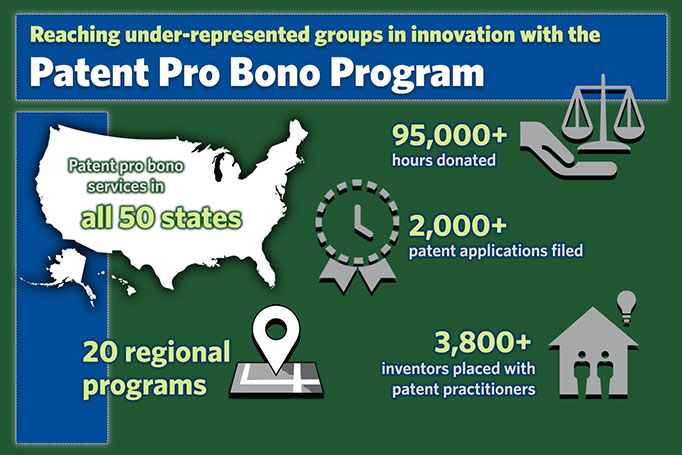
- 43% of program applicants
identified their gender as female; which is much higher than the proportion of
female inventors named on U.S. patent applications (13%);
- 35% of applicants identified
as African American or Black;
- 13.8% of applicants
identified as Hispanic;
- 7.9% identified as being a
veteran;
- 6.1% identified as either Asian, Pacific Islander, or Hawaiian Native, exceeding existing proportions in the U.S. population; and
- 1.6% identify as American Indian or Alaska Native.
Those are real numbers, real results. Real people benefiting from resources and opportunity, which yields robust, inclusive innovation that makes our country stronger.
There is a consistent theme that runs through our USPTO pro bono programs – providing critical assistance to under-resourced inventors, serving as the bridge to an inclusive innovation economy. By expanding access to pro bono legal services, we can help more under-resourced and underrepresented innovators protect their ideas and bring them to impact. And with the recent passage of the Unleashing American Innovators Act (UAIA), we are poised to build upon these programs, and expand their reach to provide more resources, services and opportunities.
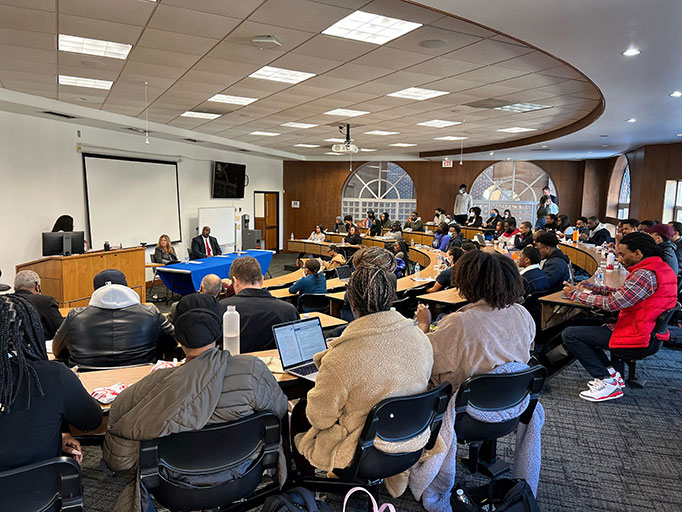
To that end, we encourage inventors and practitioners to participate in our upcoming listening sessions regarding our patent pro bono program (inventor session is June 5; practitioner session is June 7). These sessions will help inform the study we are undertaking on pro bono IP services as part of the UAIA. It is important to hear from you so that we can find ways to improve the services of our regional programs so that they best serve those who use the services.
When we meet people where they are, we bring more people into the innovation ecosystem. That is one of our top priorities. Thank you to all who help make our pro bono programs a success. To entrepreneurs and inventors – please learn more about our programs, and the many ways that the USPTO can help you on your journey.
Posted at 08:42AM May 22, 2023 in USPTO | Comments[1]
Announcing the winners of the 2023 National Patent Application Drafting Competition
Guest blog by Vaishali Udupa, Commissioner for Patents of the USPTO
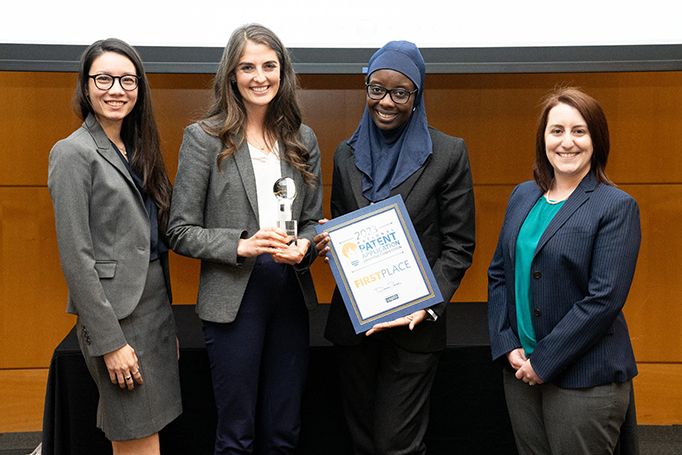
Winning team of the 2023 National Patent Application Drafting Competition, Khailee, Bree, Rita, and Maria, from the George Washington University Law School (Photo by Jay Premack/USPTO)
On April 14, law students gathered from around the country in the exciting final round of the National Patent Application Drafting Competition (NPADC) at USPTO headquarters in Alexandria, VA. The competition challenges the teams on the fundamentals of patent prosecution, including drafting a patent application and arguing its patentability. This year, a record breaking 75 teams (250 students) entered the competition. It was a thrill to serve as one of the judges in the final round and to see the finalists defend their hypothetical inventions.
For the last six months leading up to the national round, the student teams worked on hypothetical invention statements. They searched the prior art, prepared specifications, and drafted claims, all while participating in the USPTO’s patent prosecution boot camps and other training sessions. After the regional rounds in March, there were five regional finalists: The George Washington University Law School (Eastern region), University of Detroit Mercy School of Law (Midwest region), University of Missouri-Kansas City School of Law (Rocky Mountain region), University of Southern California Gould School of Law (Silicon Valley region), and University of Wisconsin Law School (Texas region). I would like to congratulate all the competing teams, finalists, and this year’s first place winner, George Washington University Law School! I was incredibly impressed by the quality and caliber of submissions and presentation by the students in this year’s competition. Their analytic and oratory skills give me great hope for the future of the IP field and the potential impact these students will have when they enter the legal world.
According to Bree, a member of this year’s winning team:
"Preparing for and presenting at both the regional and final competitions was a highlight of my law school career and I am so grateful for my incredible teammates, our coach, the GW Law faculty and staff, and the USPTO for their encouragement and support. I am confident that the relationships built and patent drafting and prosecution skills learned, throughout the competition life cycle, will pay dividends in my career as a patent attorney. I think that is the most important win.”
Since its beginnings as a regional competition led by our Elijah J. McCoy Midwest Regional Office in Detroit in 2014, the NPADC has expanded nationwide, with participation from law school teams from across the country and all our USPTO regional offices. The competition is an excellent opportunity for students to gain practical and indispensable experience drafting and prosecuting patents and to hone public speaking and communication skills. Students are also able to build vital connections through networking events throughout their participation. It is a great opportunity for students interested in a career in patent law.
The NPADC has been successful due to the overwhelming support from the intellectual property (IP) law community. The USPTO works closely with the American Intellectual Property Law Association in organizing the competition, as well as with local attorneys, local bar associations, local Inns of Court, and law school faculty mentors.
Do you want to learn more about the NPADC? It’s not too early to start planning a team for next year’s competition. Subscribe to our email updates to hear the latest, or contact PatentDraftingCompetition@uspto.gov with any questions.
Posted at 08:53AM May 02, 2023 in ip | Comments[14]
